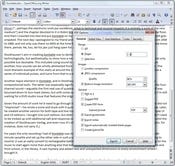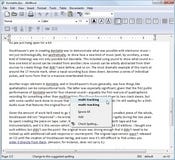In search of an alternative to Microsoft Office, we test OpenOffice.org, StarOffice from Sun, IBM's Lotus Symphony, KOffice for Linux, and AbiWord.

This story originally appeared Dec. 8, 2008.
Bit by bit, the Microsoft monopoly on office productivity applications is receding -- and one of the most important ways this is happening is through the proliferation of open source productivity suites. The most obvious example is OpenOffice.org, now in a landmark third release, but they're also not the only ones in town anymore.
| |
| |
In this review I've taken a look at OpenOffice.org's most recent release, along with the commercially-supported StarOffice from Sun, IBM's reworking of OO.o as Lotus Symphony, the KOffice suite for Linux, and the minimal but still useful AbiWord. Talking about how these would entirely replace Microsoft Office would be misleading, since not everyone might be doing that -- so I've looked at each product as far on its own merits as possible.
OpenOffice.org 3
OpenOffice.org
OpenOffice.org 3 is an evolutionary, rather than revolutionary, step forward from OO.o 2. It doesn't make as radical break from previous editions the way Microsoft Office 2007 was such a total departure from 2003. That should come as a comfort to those already alienated by Office '07. (Disclaimer: I like the ribbon interface, but I'm just as comfortable with plain old dockable toolbars as well.)
The big new things in OO.o 3 are actually a lot of small new things. Mac users, for one, will be happy to know version 3's now a native application. All of the applications in the suite can be summoned through a single unified interface, which can also be brought up from a system-tray launcher, which also doubles as an accelerator for the suite. The overall performance of the 3.0 suite is markedly better than 2.0, even without the app-launch accelerator -- a gimmick I resent on general principles, so I turned it off anyway.
Other new things include an equation solver and workbook-sharing functions for Calc (the spreadsheet app); support for multiple monitors in Impress, the presentation program; and support for VBA macros -- the latter being one of the bigger obstacles towards adoption from professional-level MS Office users.
Those who are already on Office 2007 can open that suite's OOXML-format files directly in OO.o. You cannot save as OOXML, though, and some things still don't seem to translate correctly from existing OOXML documents. One document with character sets from multiple languages on the same line (English and Japanese in this case) had its line spacing mangled when I imported it. The same document's line spacing was fine when I saved it as a Word 2003 document and imported that, however.
One of my longstanding favorite features of OpenOffice has been the ability to export directly to PDF without needing a plugin or virtual printer driver, with advanced things like encryption and form functionality all included. The range of options in OpenOffice.org's PDF exporter is a little broader in 3; the big new addition is PDF/A (archival) support, which insures that the PDF in question has all the properties and elements needed to be read in the future.
Some minor things still annoy me. Example: The range of tools at the bottom of the document window isn't very self-explanatory -- you'd probably never know what the little box labeled "STD" is for, or the one next to it that just shows an asterisk, unless you looked at the manual. (Documentation is the last resort, not the first, when you're dealing with software aimed at regular users.)
| |
| |
Bear in mind that the "stock" OpenOffice.org version isn't the only one out there. GoOO is built from the same source code, but mixes in some additional optimizations for speed. I've used it interchangeably with the regular OpenOffice.org build, since it's completely document-compatible, and it's both slightly faster and every bit as stable as the original. Also check out the PortableApps version of OpenOffice.org (versions 2.4.1 and 3.0 are both available), which can run from removable drive or simply be used as a way to try out the program without the hassle of a formal install.
StarOffice 9
Sun Microsystems
StarOffice
StarOffice is Sun's commercially-supported edition of OpenOffice.org, so from the outside there barely seems to be any difference at all between StarOffice and the original OpenOffice.org. Fire it up and apart from some branding changes you're presented with exactly the same interface -- and, even after some fairly in-depth peering around, the same feature set. So what's here that's worth paying $34.95 to $54.95 for (or, for that matter, worth paying anything at all for)?
The answer is three things: support, bundling, and deployment. In the same way Canonical provides paid support for Ubuntu, Sun offers the same for their edition of OpenOffice.org. The exact mix of support features varies depending on which edition you're using. The download version and the Standard edition (i.e., the boxed product) both come with a maximum of three support incidents in 60 days; the Enterprise version, which is licensed per-desktop and comes with additional deployment tools, requires a separate support contract.
The "bundling" aspect of StarOffice means you get the open source Thunderbird mail client and its Lightning calendaring extension along with the suite itself -- that is, if you elect to purchase the Standard or Enterprise editions. Those using the download version need to add those components manually, which in essence is no different from getting the stock OpenOffice.org build and doing the same.
Other things included only in the Enterprise edition are the Microsoft Office macro converter tool (OO.o lets you run VBA macros as-is, not convert them to OpenOffice.org's native macro language) and NetBeans extensions for the suite. In short, they're tools for those who've made a sizeable existing investment in MS Office, and want to roll that investment over into something a little less closed-ended.
One area where Sun's made major contributions to the OpenOffice.org ecosystem, apart from StarOffice itself, is the galaxy of add-ons they've written for the system. The PDF importing and editing extension is good for basic tweaking of text on a form, but not as good for more advanced manipulation. Some PDFs -- including ones I produced in OpenOffice itself -- didn't import at all. The weblog publishing extension works with all the major blog APIs -- Wordpress, Movable Type, Metaweblog, etc. -- but the features available are paltry compared to other, dedicated blog clients.
I especially liked the MediaWiki extension, though, which lets you edit and publish directly to or from sites that use the MediaWiki software (Wikipedia, for instance) without needing to know the MediaWiki markup language.
KOffice 2.0 Beta 3
KDE e.V.
KOffice
Developed for use with the KDE desktop environment in Linux, KOffice sports the broadest and richest range of apps of the suites here. The Beta 3 edition of KOffice 2 turned out to be more than stable enough to look at for this review, although the single biggest caveat is that it's only available for Linux. There is an unofficial Macintosh edition, and an ongoing project to port KDE and KDE-compatible apps to Windows, but the only KOffice application that currently exists in a Windows incarnation is the database app Kexi.
| |
| |
For the sake of maximum compatibility, I tried out KOffice under Kubuntu, which includes KOffice in its repositories. Not all distributions feature it there. Note that KOffice can run under GNOME or KDE, although for the best possible appearance you'll want to use the latter. Each of the individual KOffice applications can be run on their own, or within the framework of the KOffice Workspace where the various applications can be run under a tabbed interface. The Workspace interface needs as big a screen as you can throw at it to be useful, but anything 1024x768 or larger should be fine.
Aside from the usual mix of word processor, spreadsheet, presentation application and database system, KOffice also includes three graphics tools -- a flowcharting app, a vector-drawing program and a raster-design program -- a project-management system, a report creator, a charting/graphing utility and a math formula editor. This makes it a slightly better choice for those who want or need such tools, provided they have the platform to run it.
The breadth of tools isn't the only good thing. A fair amount of thought has been put into the presentation and layout of the applications themselves -- they're not difficult to navigate, and the panels available in things like Krita, the graphics-editing app, are coherently laid out. One thing that bothered me about Krita: there's CMYK colorspace support but no actual CMYK-model color picker. It's possible to take an existing image and break it into CMYK separations, though, which makes it relatively easy to do things like process black printing with it.
There are also some potential cross-format gotchas, which I admit may well be beta issues. A document I'd created in Word 2003 and re-saved to ODF through OpenOffice opened in KOffice with some of its formatting mangled. When I re-opened the same Word 2003 file directly in KOffice, it appeared (and re-saved) correctly. Documents newly created in KOffice or OpenOffice, though, worked fine.
Lotus Symphony 1.2
IBM Corporation
Lotus Symphony
Also derived from the OpenOffice.org codebase, but to very different ends, IBM Lotus Symphony was recently introduced as a rejuvenation of the Lotus Symphony brand name. It's much less broad than OpenOffice.org itself -- there's only three major applications in the suite -- but there's also been that much more attention paid to each individual app. The whole suite also has a bit more polish and finesse to it, possibly because the range of applications is that much narrower to begin with.
| |
| |
Symphony's three apps are a pretty good reflection of what most people do with an office suite: write documents, create spreadsheets, and assemble presentations. This doesn't mean other additions to the suite won't follow later on, though, and the suite checks automatically for new components or upgrades to existing ones. Converts from Office 2007 should be warned that OOXML is not supported out of the box, and right now there doesn't appear to be a plugin that supports it.
As with the KOffice suite, the individual apps all run within a tabbed interface. IBM's replaced the default OpenOffice.org icons and tools with a much nicer, more polished set of elements, including a set of dockable side panels for text properties that doesn't show up in the original program. That said, within each program, the feature mix is almost exactly the same as OpenOffice itself.
Sometimes that means features I could live without: the word-completion feature, enabled by default, is one of the first things I turned off.
IBM's clearly intended Symphony to be a starting point and a framework for further development, both in synchrony with OpenOffice and apart from it. One good example of this is the plugins available for Symphony -- they're patterned after the plugin system in OpenOffice.org as well, but the available plugins are entirely different and it doesn't appear that plugins from OpenOffice.org can be used in Symphony or vice versa. There also aren't as many plugins available for Symphony but a few of them look truly useful, such as one that exports presentations to standalone Flash files.
AbiWord 2.6.4
AbiSource
AbiWord
AbiWord is worth mentioning in the context of these other programs -- it's a free and open source word processing application that continues to be developed and maintained by a community of users. Its feature base is not as broad as OpenOffice.org -- it's only a word processor, not a whole suite of applications. But that may also be a major point of appeal, since it only takes up about 15MB on installation and runs with amazing swiftness.
| |
| |
As the name implies, AbiWord is essentially a clone of the "classic" Microsoft Word's core features. Many of the common things you'd use Word for -- letters, reports, mail merges, revision tracking -- are all available here. It's not suitable for really professional use, but students and individuals who aren't doing enterprise-level work will find it just about perfect. It's also available cross-platform, so if you get started using it on Windows, you'll be able to take it with you if you switch to Linux.
Classic Word documents (Word 97-2003) open as-is, and a plugin's readily available for OpenOffice and ODF files, but there's as yet no support for Office 2007 OOXML. Not everything opens perfectly, though: when I tried opening a Word document with multiple languages (English and Japanese, in this case), the non-English text didn't render correctly. To that end, AbiWord is probably best for creating entirely new documents instead of dealing with existing legacy ones.
The roster of clever little features that go with AbiWord is endearing. The program's export-to-HTML function lets you package any images in the document within the HTML file itself, using base64 encoding. Third-party plugins add their own gamut of functionality,too -- mostly import/export of various file formats, but the formats supported include things like LaTeX, WordPerfect and Clarisworks. Last but not least, you can run AbiWord in a PortableApps package.
Summary
It's hard to go wrong with OpenOffice.org as a default choice. Aside from enjoying the support of both Sun and IBM (albeit in different ways), it's expanded its cross-compatibility with Microsoft Office, making it that much easier for people to migrate and continue existing work.
Symphony is quite polished if not as fully loaded as the original OpenOffice.org suite; it's going to be worth keeping an eye on this to see where it goes when it enters the 2.0 and 3.0 phases. StarOffice's main draw is the support and deployment features that go with it, but those are for-pay only -- albeit at a very reasonable per-user cost.
KOffice has more media/graphic designer tools, but that much less of a prospective audience due to being Linux-only. And finally, AbiWord is small and light, convenient if you just want a word processor and nothing else.
About the Author(s)
You May Also Like















